Abstract
Sugar palm fibers (SPF) reinforced vinyl ester (VE) composites were prepared in this study. The SPFs were obtained from three different geographical locations: Kuala Jempol (Peninsular Malaysia), Tawau (West Malaysia), and Tasik Malaya (Indonesia). The SPFs were utilized as reinforcement material with a fixed loading of 10 wt.%. The reinforced VE composites were prepared using a wet lay-up compression moulding method. The physical properties examined were water absorption, thickness swelling, and moisture content. To determine the strength of the SPF composites, tests on the tensile, flexural, and impact strength related to mechanical properties were completed. A thermogravimetric analysis (TGA) was completed to observe the thermal properties. This study confirmed that the properties of the composites were affected by the strength of the fiber. The SPF/VE composites obtained from Kuala Jempol had the highest tensile, flexural, and impact strength compared to the SPF/VE composites from Indonesia and Tawua. In addition, SPF Jempol/VE also recorded the highest percentage of water absorption, thickness swelling, and moisture content. A comparison of thermal properties showed that SPF Tawau/VE had highest percentage of mass loss between fibers from the three geographic locations.
Download PDF
Full Article
Comparative Study of Physical, Mechanical, and Thermal Properties on Sugar Palm Fiber (Arenga pinnata (Wurmb) Merr.) Reinforced Vinyl Ester Composites Obtained From Different Geographical Locations
M.R.M. Huzaifah,a S.M. Sapuan,b,* Z. Leman,band M.R. Ishak c
Sugar palm fibers (SPF) reinforced vinyl ester (VE) composites were prepared in this study. The SPFs were obtained from three different geographical locations: Kuala Jempol (Peninsular Malaysia), Tawau (West Malaysia), and Tasik Malaya (Indonesia). The SPFs were utilized as reinforcement material with a fixed loading of 10 wt.%. The reinforced VE composites were prepared using a wet lay-up compression moulding method. The physical properties examined were water absorption, thickness swelling, and moisture content. To determine the strength of the SPF composites, tests on the tensile, flexural, and impact strength related to mechanical properties were completed. A thermogravimetric analysis (TGA) was completed to observe the thermal properties. This study confirmed that the properties of the composites were affected by the strength of the fiber. The SPF/VE composites obtained from Kuala Jempol had the highest tensile, flexural, and impact strength compared to the SPF/VE composites from Indonesia and Tawua. In addition, SPF Jempol/VE also recorded the highest percentage of water absorption, thickness swelling, and moisture content. A comparison of thermal properties showed that SPF Tawau/VE had highest percentage of mass loss between fibers from the three geographic locations.
Keywords: Sugar palm fiber; Vinyl ester composites; Physical properties; Mechanical properties; Thermal properties
Contact information: a: Laboratory of Biocomposite Technology, Institute of Tropical Forestry and Forest Products (INTROP), Universiti Putra Malaysia, UPM 43400 Serdang, Selangor, Malaysia; b: Department of Mechanical and Manufacturing Engineering, Universiti Putra Malaysia, UPM 43400 Serdang, Selangor, Malaysia; c: Department of Aerospace Engineering, Universiti Putra Malaysia, UPM 43400 Serdang, Selangor, Malaysia; *Corresponding author: sapuan@upm.edu.my
INTRODUCTION
Green composite materials have been developed to reduce environmental problems and dependency on glass fiber. Natural fiber, an alternative to glass fiber, is used as a reinforcement material in composites because of its mechanical and physical properties that include flexibility, stiffness, renewability, light weight, and biodegradability (El-Shekeil et al. 2012; Ramesh et al. 2013). In addition, natural fibers are abundant, non-abrasive to equipment, and require less energy for processing.
Various types of natural fibers can be used as reinforcement in polymer composites, such as jute, kenaf, ramie, bamboo, hemp, banana, oil palm fibers, and sisal. In this study, sugar palm fiber (SPF; also called ijuk) from Arenga pinnata) trees was used to reinforce a polymer matrix in vinyl ester (VE) composites. Ijuk is a black fiber that covers the tree and can be extracted directly without a secondary process to yield the fibers (Leman et al. 2008; Sahari et al. 2012b). Other products of ijuk fiber are brushes, broom, paintbrushes, doormats, rope, carpet, and septic tank base filters.
Previously, many studies related to SPF composites have been conducted. Leman et al. (2005) studied the impact properties of SPF reinforced epoxy composites between chopped and long fibers. The long fibers have the highest impact strength compared to chopped fibers, and the use of SPF as reinforcement improves the impact resistance. Sastra et al. (2006) studied the tensile properties of SPF reinforced epoxy composites with three different orientations. The results indicated that woven roving fiber has a better adhesion between the fiber and matrix compared to the long random fiber and chopped random fiber orientations.
Leman et al. (2008) conducted research on the moisture absorption behaviour of sugar palm reinforced epoxy composites with two different fiber compositions that were 10 wt% and 20 wt%. They concluded that composites with 20% fiber loading recorded the highest amount of moisture. Ali et al. (2010) prepared SPF reinforced epoxy composited by using 10 wt% fibers to study the effect of aging on the composites concerning their mechanical properties. The aged fiber improved the tensile strength of the composites and believed that the aging process causes the composites matrix to become more compact, which can lead to denser and harder products. Flexural properties of alkaline treated SPF reinforced epoxy composites (Bachtiar et al. 2010) and tensile properties of alkaline treated SPF reinforced thermoplastic polyurethane composites (Mohammed et al. 2016) were previously studied. However, no study has determined whether SPF from different locations influences the properties of the fiber-reinforced composites.
Table 1. Types of Resin and Fiber From Sugar Palm Tree Used in Previous and Current Studies
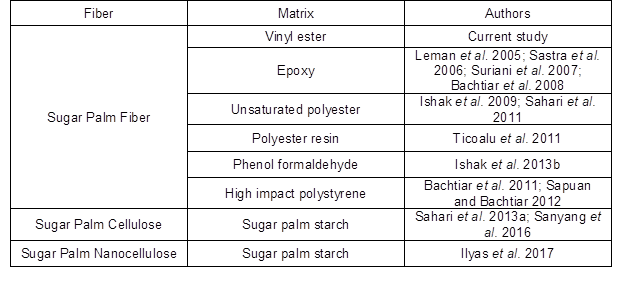
Table 1 shows experiments that have been conducted using SPF as reinforcement with various matrix types. However, no study has been reported using SPF as a reinforcement and VE as a matrix resin. The VE has similar mechanical properties to epoxy resin, particularly concerning hydrolytic stability. In addition, VE is easy to handle at room temperature compared to epoxy resin, which offers greater control over cure rate and reaction conditions. Using VE as a matrix resin may also improve the dimensional stability, chemical resistance, strength, and stiffness of the composites. In addition, the filler reinforcement was needed to increase the performance and reduce the cost of the resin (Ku et al. 2014). According to Aprilia et al. (2014), VE costs less than epoxy resins. Therefore, the objective of this study was to determine the SPF properties from three geographical locations reinforced by VE composites concerning their mechanical, physical, and thermal properties.
EXPERIMENTAL
Materials
Preparation of fibers
The SPFs or ijuk fibers were prepared according to previous work (Huzaifah et al. 2017). The SPFs were obtained from three different geographical locations: (1) Kampung Kuala Jempol, Negeri Sembilan, (2) Kebun Rimau Sdn Bhd, Balung River, Tawau, Sabah, and (3) Kampung Naga, Tasikmalaya, Indonesia, as shown in Fig. 1. According to the website Weather Spark (2017a, b, c), the average weather in Tawau is warm, oppressive, and overcast with temperatures varying from 23 °C to 31 °C . The climate in Kuala Jempol is hot, oppressive, and overcast with temperatures varying from 22 °C to 32 °C. The climate in Tasikmalaya is similar to Tawau with temperatures varying from 20 °C to 31 °C. According to the website Climate Data (2015a, b, c), the average rainfall in Tawau is 1966 mm, in Tasikmalaya is 3442 mm, and in Kuala Jempol is 1940 mm. The general soil properties for the three location is shown in Table 2.
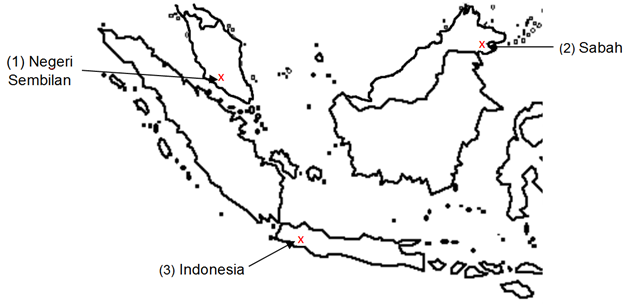
Fig. 1. Sugar palm fibers obtained from three geographical locations: (1) Kampung Kuala Jempol, Negeri Sembilan, (2) Kebun Rimau Sdn Bhd, Balung River, Tawau, Sabah, and (3) Kampung Naga, Tasikmalaya, Indonesia
In this experiment, matured sugar palm trees (after undergoing the flowering stage with an age older than 6 years) with the height of 15 m were selected from each location. The fibers were all collected from the trunk of the tree. The fibers were washed and air dried for 24 h before being dried in the oven at 85 °C for another 24 h. Finally, the fibers were ground and segregated using an automatic shaker sieve. The range of length sizes was between 100 µm to 425 µm to create composite samples. All of the fibers were labelled as SPF from Kuala Jempol, SPF Tawau, and SPF Indonesia.
Table 2. General Soil Properties of Three Geographical Locations (Hanafi and Salwa 1998; Husni et al. 1990; Kharisun and Budiono 2015)

The thermosetting resin used in this study was vinyl ester (VE) resin. Methyl ethyl ketone peroxide (MEKP) was used as a hardener. The VE and MEKP were obtained from Chemrex Corporation Sdn. Bhd., Balakong, Malaysia. A wet lay-up compression moulding process was used for the sample preparation of SPF reinforced VE composites. A rectangular mould constructed of an aluminium sheet with a certain dimension was used for the composite samples. The SPF percentage used in the composites was 10 wt%. The composite samples were prepared by mixing 10 wt% of SPF and 87.5 wt% of VE.
First, the SPF was gradually added to the VE resin and stirred using a mechanical stirrer at 100 rpm to 250 rpm until the mixture was uniformly distributed. Then, 2.5 wt% of MEKP was added to the composite mixture for curing. Finally, the mixture of the SPF and VE resin were poured into the aluminium mould and were pressed by a cold press machine and left to cure at room temperature for 24 h. The samples were cut from the cured composites into certain dimensions according to the ASTM standards for the tensile test, flexural test, and impact tests, as detailed below.
Methods
Water absorption
The water absorption percentages of the sugar palm fibers were determined using Eq. 1. Three samples (10 mm × 10 mm × 3 mm) were prepared and each sample was replicated five times. The samples were weighed first before being immersed (W0) in fresh water for 24 h at room temperature. After 24 h of immersion, the samples were weighed again (W1).
![]()
Moisture content
The moisture content was evaluated based on a method used by other research group (Yusriah et al. 2014; Nadlene et al. 2016). Three samples (10 mm × 10 mm × 3 mm) were prepared, and each test was replicated five times. The samples were weighed before being heated (M0) in an oven for 24 h at 105 °C. After 24 h in the oven, the fiber was weighed again (M1). Moisture content was calculated using Eq. 2.
![]()
Thickness swelling
The thickness swelling testing was conducted based on a method used by another research group (Sahari et al. 2012a). Three samples (10 mm × 10 mm × 3 mm) were prepared, and each sample was replicated five times. The average value was taken as the final result. The initial thickness (T0) was taken first before being immersed in fresh water for 24 h at room temperature. After 24 h of immersion, the final thickness (T1) was taken. Thickness swelling was calculated using Eq. 3.
![]()
Tensile testing
A tensile test is a method to determine the mechanical strength of natural fibers. Several mechanical properties can be obtained from the tensile test such as tensile stress, tensile strain, maximum elongation, and Young’s modulus. An INSTRON 5556 (Norwood, MA, USA) was used to obtain the SPF tensile properties and was tested according to ASTM D 5083 (2002). The samples were prepared with dimensions of 250 mm x 25 mm x 3 mm. The gauge length of the SPF samples was 150 mm, and the cross-head speed was 5 mm/min with a 5 kN load cell. To perform the test, three samples of SPF/VE from each location with five replications of each sample were prepared.
Flexural testing
The flexural test was conducted according to ASTM D-790 (2010) at room temperature. The test was carried out on three samples of SPF/VE from each location with five replications of each sample using a universal testing machine (INSTRON 5556) with a 5 kN load cell and crosshead speed maintained at 2 mm/min. The samples were prepared with dimensions of 127 mm x 12.7 mm x 3 mm. The support span length was set at a ratio of 16:1 to the thickness of the samples.
Impact testing
The izod impact test was conducted according to ASTM D256 (2002) at room temperature. The impact tests were performed on three samples of SPF/VE from each location with five replications of each sample using a digital INSTRON CEAST 9050 pendulum impact tester. The samples were prepared with dimensions of 60 mm x 13 mm x 3 mm. The impact strength was calculated based on the impact energy and cross section area of the specimen as shown in Eq. 4:
![]()
Thermogravimetric analysis (TGA)
The thermal degradation behaviour of the composites was analysed by TGA with respect to weight loss due to increased temperatures. The TGA was performed with a Q series thermal analysis machine from TA Instruments (New Castle, DE, U.S.A.). The analysis was carried out in aluminium pans under a dynamic nitrogen atmosphere in temperature range of 25 °C to 900 °C at a heating rate of 10 °C/min.
Scanning electron microscope (SEM)
The morphology of the fiber surface was observed under scanning electron microscope (SEM) instrument model Hitachi S-3400N (Kyoto, Japan). To obtain cross-sectional morphology of the SPF, the fibers were immersed in liquid nitrogen to harden. Afterward, the samples were coated with a thin layer of gold. The acceleration voltage was 15 kV, and the distance to examine the sample was 50 mm.
RESULTS AND DISCUSSION
Physical Properties of SPF/VE Composites
Water absorption and thickness swelling
Figure 2 shows the percentage of water absorption and thickness swelling of the SPF/VE composites from three different geographical locations.

Fig. 2. Percentage of (a) water absorption and (b) thickness swelling of SPF/VE composites from three different geographical locations
The water absorption test calculated based on the weight of the specimens before and after water immersion for each day until day 7. The thickness swelling was calculated based on the thickness of the specimens before and after water immersion for each day until day 6. Based on the Fig. 2 below, the SPF Jempol/VE recorded the highest percentage of water absorption and thickness swelling, and this was followed by SPF Tawau/VE and SPF Indonesia/VE. As shown in Table 3, these results were supported by previous research on single fiber tensile tests in which Kuala Jempol fiber had the highest water absorption, 161.96 ± 34.04%, while Tawau and Indonesia were 156.56 ± 19.64% and 80.32 ± 13.3%, respectively (Huzaifah et al. 2017). According to Sahari et al. (2011), water absorption, thickness swelling, and moisture content are affected by the hydrophilic behavior of the natural fibers and not by the hydrophobic behavior of the polymers. All lignocellulosic materials that consist of cellulose, hemicellulose, and lignin contribute to water absorption behavior. These elements contain -OH groups that attract water molecules. Therefore, when a composite containing lignocellulosic material applied in moist areas, the composite will absorb water (Sahari et al. 2011).
Table 3. Physical Properties of Sugar Palm Fiber from Three Different Locations (Huzaifah et al. 2017)

Several natural mechanisms in water transportation allowed the water to penetrate into the natural fiber reinforced composites. Small cracks in the polymer matrix allowed the water molecules to infiltrate, while inward diffusion of water molecules occurred when there were microgaps between the polymer chains. In addition, the capillary effect could have transported water through the fiber/matrix interface. These conditions may have caused undesirable changes or deformation in the mechanical properties, such as plasticizing, swelling, or degradation.
Table 4. Celluloses Content and Water Absorption of Single Fibers (Huzaifah et al. 2017)

Table 5. Water Absorption and Thickness Swelling for Selected Natural Fiber-composites (Anwar et al. 2009)

In addition, this hydrophilic behaviour causes difficulty in attaining adhesion between fiber/matrix composites, which weakens the composite product in applications (Nguong et al. 2013). Therefore, water absorption and thickness swelling on natural fiber reinforced composites are important factors to be considered in product applications. These results were supported by previous findings on single fibers, in which the relationships between holocellulose content and water absorption affect behaviour (Huzaifah et al. 2017). Previous research has indicated that SPF obtained from Kuala Jempol has the highest holocellulose content (54.5%) that contributes to the highest water absorption (161.96 ± 34.04%), followed by Tawau and Indonesia, as shown in Table 4. The water absorption and thickness swelling for selected natural fiber reinforced composites Kenaf/PP, Acacia/PP, Banana/PP, and EFB/PP were compared in Table 5. The SPF/VE had slight similarity in water absorption with Kenaf/PP and Acacia/PP, which was in a range of 1.30% to 1.60%. For SPF/VE, the thickness swelling was low compared to other natural fiber composites, which were below 0.65%.
Moisture content
Figure 3 shows the percentage of moisture content of the SPF/VE composites from three different geographical locations. Moisture content is one of the important properties that must be considered when using natural fibers as reinforcement in material composites. Natural fiber with high moisture content may reduce the tensile strength, dimension, stability, and porosity formation of the composites (Razali et al. 2015; Huzaifah et al. 2017). Hence, low moisture content is required for product applications. Moreover, composites with high moisture content fibers may easily degrade due to retained water ((Rowell et al. 2000). From Fig. 2, SPF Jempol/VE showed the highest moisture content (1.99%), followed by SPF Tawau/VE (1.86%) and SPF Indonesia/VE (1.80%).
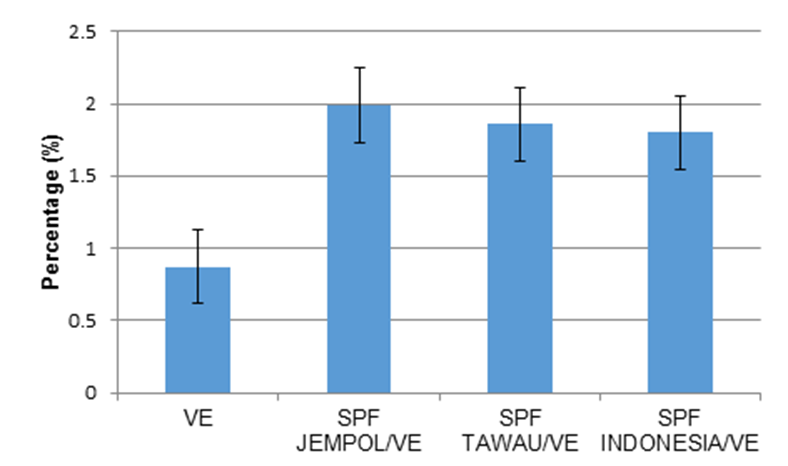
Fig. 3. Percentage of moisture content of SPF/VE composites from three different geographical locations
Mechanical Properties
Tensile properties
The SPF reinforced VE composites (Kuala Jempol, Tawau, and Indonesia) were evaluated, and their strength strain performance is shown in Fig. 4. The strength increased because of an increase of strain value and then underwent a failure at a certain point. According to Ishak et al. (2012), the defect may be associated with the weak strength of the fiber when the fiber was pulled under load or stress. Therefore, the fibers used as a reinforcement material for product manufacturing should have minimum defects. If not, the failures will start to occur at the defect point.
The tensile properties were measured to evaluate the mechanical properties of SPF reinforced VE composites. The tensile strength and tensile modulus were investigated, and the results are shown in Fig. 5. The SPF Kuala Jempol/VE fiber had the highest average tensile strength at 24.06 MPa, while the SPF Tawau/VE and SPF Indonesia/VE fibers were 19.74 MPa and 17.37 MPa, respectively. These results were supported by previous research on single fiber tensile tests in which the Kuala Jempol fiber had the highest tensile strength, 233.28 ± 71.17 MPa while Indonesia and Tawau were 219.30 ± 79.71 MPa and 211.04 ± 81.19 MPa, respectively. The strength properties of natural fiber were influenced by cellulose content (Reddy and Yang 2005; Ishak et al. 2013a; Razali et al. 2015; Huzaifah et al. 2017). From the results of the cellulose content in Table 6, Kuala Jempol fiber had the highest cellulose content at 44.53%, while Indonesia and Tawau were 44.47% and 43.8%, respectively.
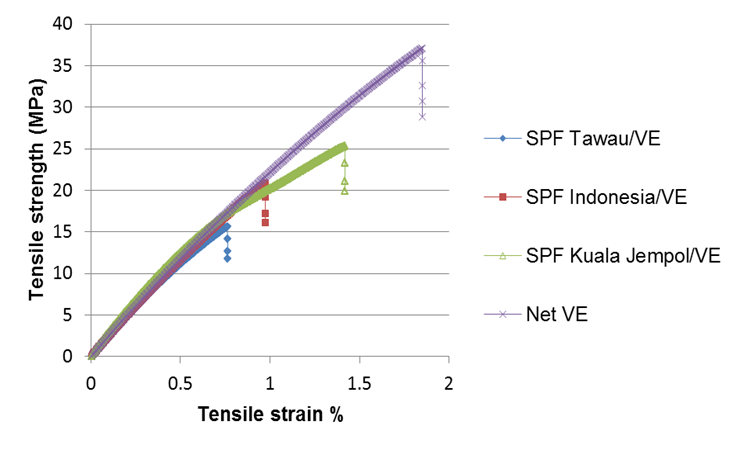
Fig. 4. Tensile strength and strain of SPF from different geographical locations reinforced VE composites
Table 6. Chemical Composition for Sugar Palm Fiber Obtained From Three Different Geographical Locations (Huzaifah et al. 2017)

The tensile modulus was used to measure the resistance of the material to elastic deformation under load. It is defined as the ratio of the stress (force per unit area) along an axis to the strain (the ratio of deformation over an initial length) along that axis over the range of stress in which Hooke’s law holds. As shown in Fig. 5, Tawau fiber had the highest average tensile modulus, 2549.54 MPa, while Kuala Jempol and Indonesia were 2525.04 MPa and 2487.45 MPa, respectively.
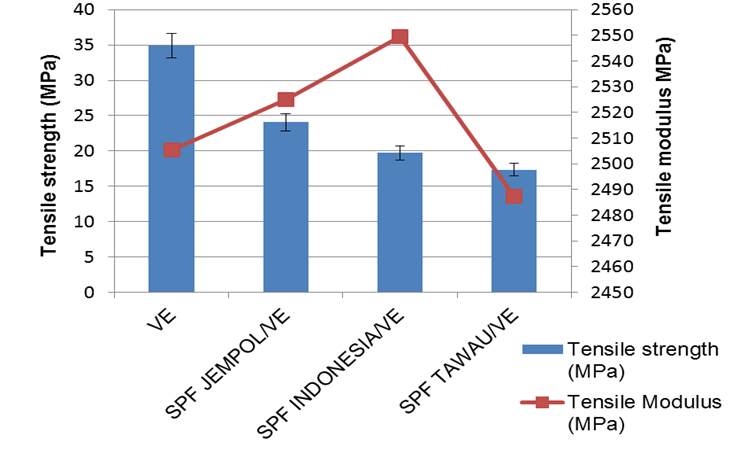
Fig. 5. Tensile strength and tensile modulus of SPF reinforced VE composites
Flexural properties
Figure 6 shows the strength and modulus of SPF obtained from the three different geographical locations reinforced VE composites.
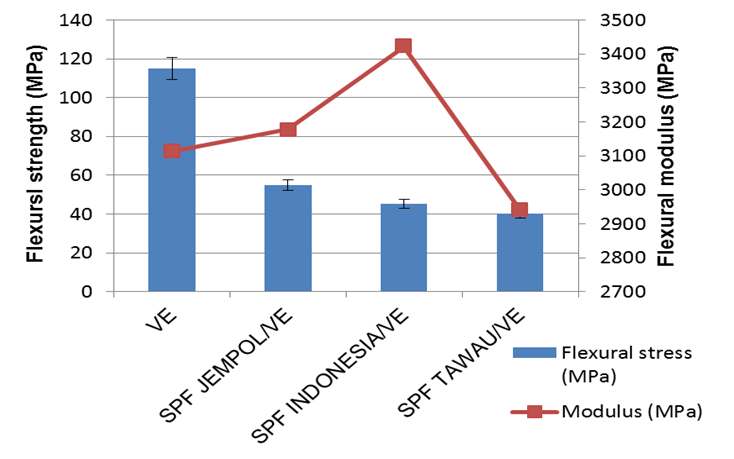
Fig. 6. Flexural test of SPF reinforced VE composites
The results show a similar trend with the tensile test where the strength and modulus increased with increased cellulose content. The SPF Jempol/VE had the highest flexural strength of 58.9 MPa and modulus values of 3177 MPa, which might been influenced by the adhesion and wettability between the fibers and matrix. The SPF Tawau/VE had the lowest value of strength and modulus (40.1 MPa and 2841 MPa, respectively), which might be attributed to the poor wetting of the fiber and matrix resin. All composites showed effective stress transfer and interaction effect between the fibers and matrix.
Impact properties
Figure 7 shows the impact properties of SPF reinforced VE composites obtained from three different geographical locations. The introduction of fiber reduced the impact strength for all samples compared to the neat VE composites. This may have been caused from the fiber dispersal, which led to the local concentration point of pressure and weak interfacial adhesion. An example of this can be observed in Fig. 8, where some areas show a gap between the fibers and matrix. According to Nadlene et al. (2016), there are relationships between fiber-matrix interfacial adhesion and stress transferred from the impact force to the fiber through the matrix. The highest impact strength of SPF reinforced VE composites were from Kuala Jempol, with a value of 7.72 kJ/m2, followed by SPF Indonesia/VE and SPF Tawau/VE with values of 6.27 kJ/m2 and 5.07 kJ/m2, respectively.

Fig. 7. Impact test of SPF reinforced VE composites
SEM images in Fig. 8 show the overview of the structure of the composites made from SPF from Kuala Jempol, Tawau, and Indonesia. It can be seen that there were good interfacial bonding between matrix and fiber from Kuala Jempol (Fig. 8 a). As shown, the fiber was embedded firmly in the matrix. It is evidence for good tensile and flexural strength of the composites. Fiber pullouts and fiber breakage also can be seen in Fig. 8. This failure can lead to a decrease in mechanical strength of the composites.
Thermal Properties
A limiting factor to using natural fibers as reinforcement in bio-composites is their low thermal stability. The TGA was carried out to analyse the resistance of natural fiber composites after exposure to several temperatures. In addition, this analysis was completed to ensure that natural fiber composites could endure certain levels of heat when applied for outdoor applications.
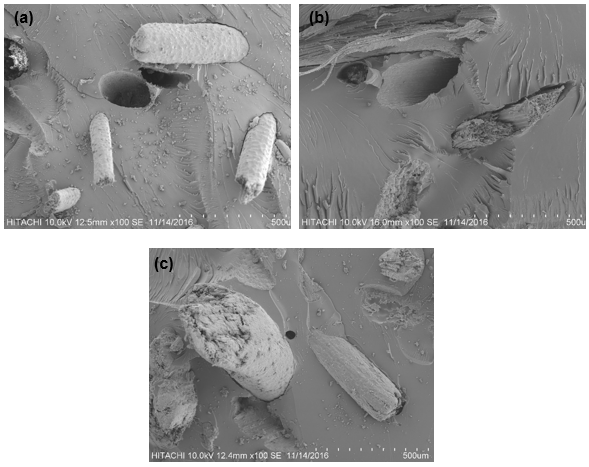
Fig. 8. SEM of cross section of SPF from (a) Kuala Jempol, (b) Tawau, and (c) Indonesia
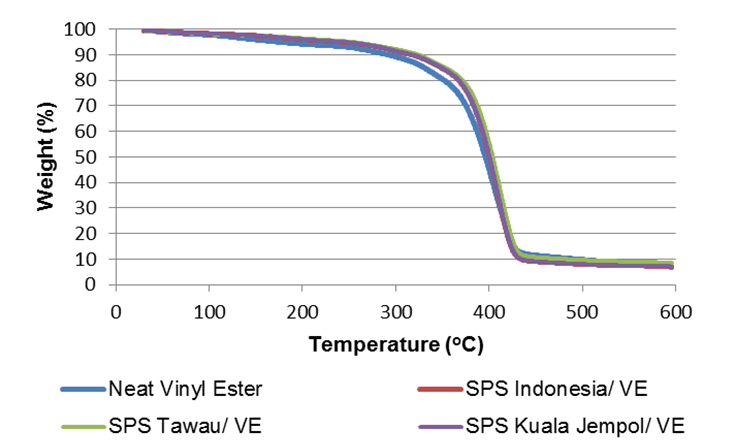
Fig. 9. TGA of SPF reinforced VE composites from different locations
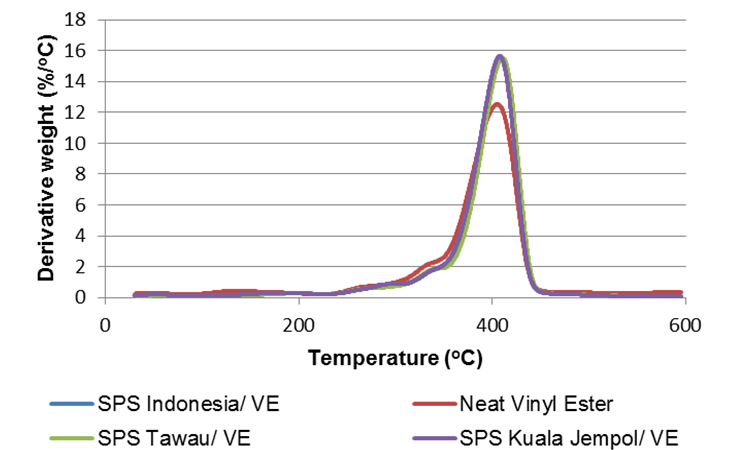
Fig. 10. Differential thermogravimetric (DTG) of SPF reinforced VE composites from different geographical locations
Figures 9 and 10 present the TGA and DTG curves for neat VE and SPF/VE composites obtained from three geographical locations. There were no notable differences in the thermal degradation value of SPF composites obtained from the three locations. Overall, the SPF composites showed similar degradation trends. In addition, the results show that all SPF composites had thermal stability compared to the neat VE in the range of 370 °C to 420 °C. According to Huzaifah et al. (2017), there are four phases of thermal decomposition, which were moisture evaporation (45 °C to approximately 123 °C), then hemicellulose decomposition (210 °C to 300 °C), followed by cellulose (300 °C to 400 °C), and lignin (160 °C to 900 °C).
Table 7. Thermal Degradation Analysis of Neat VE and SPF/VE Composites Obtained From Three Different Locations

The first phase of decomposition happened between the ranges of 30 °C to 100°C (Ishak et al. 2012; Nadlene et al. 2016; Huzaifah et al. 2017). All composites and neat VE showed a slight mass loss between the temperatures of 300 °C to 100 °C. According to Jumaidin et al. (2017), this occurs due to the presence of moisture in the composite structure, which indicates that natural fibers have a higher moisture content at lower onset and peak degradation temperatures. From the results obtained, the SPF Tawau/VE had the highest percentage of mass loss (11.01%), followed by SPF Jempol/VE and SPF Indonesia/VE (10.05% and 9.12%, respectively). The resulted mass loss comparably with the SPF moisture contents in previous research (Huzaifah et al. 2017).
The second phase of decomposition was the hemicellulose decomposition that occurred between the ranges of 220 °C to 315 °C. According to Ishak et al. (2012) hemicelluloses have a heterogeneous polysaccharides structure that makes it for them to break apart at lower temperature. The cellulous decomposition takes place when the hemicellulose has completely decomposed, which typically happens at approximately 315 °C (Yang et al. 2007). Cellulose is more thermally stable than hemicellulose because it has a higher crystalline structure content of approximately 80%, which is the main reinforcement in the cell wall (Ho et al. 2012). For all of the SPF composites, the cellulose decomposition started at 350 °C and was completed at 420 °C. The peak temperature of the SPF cellulose structure was 410.8 °C, which was the fiber obtained from Tawau and the peak temperature of neat VE was 405.8 °C. The addition of fiber as reinforcement increased the thermal stability by 1.23%.
Lignin is the last component to decompose because it has a relatively complex structure. According to Vanholme et al. (2010), the complexity is further explained by the presence of aromatic rings with various possible branches. The lignin decomposition begins early at 160 °C and decomposes slowly until the temperature reaches 900 °C to complete this process (Yang et al. 2007). Figure 8 shows that the lignin degraded slowly within the whole range of temperatures. It is hard to decompose a lignin structure due to its complexity, which makes it difficult to see an individual peak corresponding to lignin.
According to Ross et al. (2008), the decomposition above 500 °C could be associated with carbonate decomposition. As the temperature is increased, the remains continue to decompose and cause the formation of char. From Table 5, approximately 8.57%, 8.01%, and 7.08% of the char was not completely for SPF Tawau/VE, SPF Jempol/VE, and SPF Indonesia/VE, respectively. The residue char was the end product after all uncertain substances were eliminated through the pyrolysis process (Razali et al. 2015).
From the results displayed in Table 7, the use of SPF as a reinforcement material accelerates the degradation of VE composites. This may be due to the replacement of a portion of the VE matrix with thermally stable SPF, which can increase the thermal stability of the polymer system as a whole. Ray et al. (2004) and Yusriah et al. (2016) agreed that the individual thermal degradation properties of the matrix and fibers influence the thermal degradation properties of natural fiber reinforced polymer composites.
CONCLUSIONS
Results from the physical properties found that SPF Jempol/VE showed the highest value of water absorption and moisture content.
Mechanical testing of the SPF composites on tensile, flexural, and impact strength also showed that SPF Jempol had the highest tensile, flexural, and impact strength compared to the composites reinforced by SPF from Tawau and Indonesia.
For thermal properties, SPF/Tawau had the highest mass loss and no notable difference between the other composites.
There were only slight differences in physical, mechanical, and thermal properties of SPF obtained from different geographical locations reinforced VE composites compared to other established natural fiber composites.
ACKNOWLEDGMENTS
The authors thank Universiti Putra Malaysia for funding the research grant (HiCoE 6369107). In addition, a special thanks to the Institute of Tropical Forestry and Forest Products, Universiti Putra Malaysia for providing facilities to carry out the experiment. The authors would also like to thank University Putra Malaysia for funding the Master of Science degree for the principle author under a grant research fellowship (GRF).
REFERENCES CITED
ASTM D 256-97 (2002). “Standard test methods for determining the Izod pendulum impact resistance of plastics,” ASTM International, West Conshohocken, USA.
ASTM D 790-10 (2010). “Standard test method for flexural properties of unreinforced and reinforced plastics and electrical insulating materials,” ASTM International, West Conshohocken, USA.
ASTM D 5083-02 (2002). “Standard test method for tensile properties of reinforced thermosetting plastics using straight-sided specimens,” ASTM International, West Conshohocken, USA.
Ali, A., Sanuddin, A. B., and Ezzeddin, S. (2010). “The effect of aging on Arenga pinnata fiber-reinforced epoxy composite,” Materials and Design 31(7), 3550-3554. DOI: 10.1016/j.matdes.2010.01.043
Anwar, U. M. K., Paridah, M. T., Hamdan, H., Sapuan, S. M., and Bakar, E. S. (2009). “Effect of curing time on physical and mechanical properties of phenolic-treated bamboo strips,” Industrial Crops and Products 9(1), 214-219. DOI: 10.1016/j.indcrop.2008.05.003
Bachtiar, D., Sapuan, S. M., and Hamdan, M. M. (2008). “The effect of alkaline treatment on tensile properties of sugar palm fiber reinforced epoxy composites,” Materials and Design 29(7), 1285-1290. DOI: 10.1016/j.matdes.2007.09.006
Bachtiar, D., Sapuan, S. M., and Hamdan, M. M. (2010). “Flexural properties of alkaline treated sugar palm fiber reinforced epoxy composites,” International Journal of Automotive and Mechanical Engineering 1(1), 79-90. DOI: 10.15282/ijame.1.2010.7.0007
Bachtiar, D., Sapuan, S. M., Zainudin, E. S., Khalina, A., and Dahlan, K. Z. M. (2011). “Effect of alkaline treatment and a compatilizing agent on tensile properties of sugar palm fiber-reinforced high impact polysterene composites,” BioResources 6(4), 4815-4823. DOI: 10.15376/biores.6.4.4815-4823
Climate Data (2015a). “Climate: Tawau,” (https://en.climate-data.org/location/5121/), accessed on February 2, 2018.
Climate Data (2015b). “Climate: Tasikmalaya,” (https://en.climate-data.org/location/975258/), accessed on February 2, 2018.
Climate Data (2015c). “Climate: Kuala Pilah,” (https://en.climate-data.org/location/26002/), accessed on February 2, 2018.
El-Shekeil, Y. A., Sapuan, S. M., Khalina, A., Zainudin, E. S., and Al-Shuja’A, O. M. (2012). “Effect of alkali treatment on mechanical and thermal properties of Kenaf fiber-reinforced thermoplastic polyurethane composite,” Journal of Thermal Analysis and Calorimetry 109(3), 1435-1443. DOI: 10.1007/s10973-012-2258-x
Hanafi, M. M. and Salwa, H. (1998). “Cadmium and zinc in acid tropical soils: il influence of humic acid addition on soil properties and their adsorption,” Communications in Soil Science and Plant Analysis 29(11-14), 1933-1947. DOI: 10.1080/00103629809370083
Ho, M., Wang, H., Lee, J. H., Ho, C., Lau, K., Leng, J., and Hui, D. (2012). “Critical factors on manufacturing processes of natural fiber composites,” Composites Part B: Engineering 43(8), 3549-3562. DOI: 10.1016/j.compositesb.2011.10.001
Husni, A., Shariff, M., and Zakaria, M. (1990). “Soil and foliar nutrient relationship in selected Shorea and Koompassia species in two forest reserves, Peninsular Malaysia,” Journal of Tropical Forest Science 2(4), 320-330.
Huzaifah, M. R. M., Sapuan, S. M., Leman, Z., and Ishak, M. R. (2017). “Comparative study on chemical composition, physical, tensile, and thermal properties of sugar palm fiber (Arenga pinnata) obtained from different geographical locations,” BioResources 12(4), 9366-9382. DOI: 10.15376/biores.12.4.9366-9382
Ilyas, R. A., Sapuan, S. M., Ishak, M. R., and Zainudin, E. S. (2017). “Effect of delignification on the physical, thermal, chemical, and structural properties of sugar palm fiber,” BioResources 12(4), 8734-8754. DOI: 10.15376/biores.12.4.8734-8754
Ishak, M. R., Leman, Z., Sapuan, S. M., Rahman, M. Z. A., and Anwar, U. M. K. (2013a). “Chemical composition and FT-IR spectra of sugar palm (Arenga pinnata) fibers obtained from different heights,” Journal of Natural Fibers 10(2), 83-97. DOI: 10.1080/15440478.2012.733517
Ishak, M. R., Leman, Z., Sapuan, S. M., Rahman, M. Z. A., and Anwar, U. M. K. (2013b). “Impregnation modification of sugar palm fibers with phenol formaldehyde and unsaturated polyester,” Fibers and Polymers 14(2), 250-257. DOI: 10.1007/s12221-013-0250-0
Ishak, M. R., Leman, Z., Sapuan, S. M., Salleh, M. Y., and Misri, S. (2009). “The effect of sea water treatment on the impact and flexural strength of sugar palm fiber reinforced epoxy composites,” International Journal of Mechanical and Materials Engineering 4(3), 316-320.
Ishak, M. R., Sapuan, S. M., Leman, Z., Rahman, M. Z. A., and Anwar, U. M. K. (2012). “Characterization of sugar palm (Arenga pinnata) fibers tensile and thermal properties,” Journal of Thermal Analysis and Calorimetry 109(2), 981-989. DOI: 10.1007/s10973-011-1785-1
Jumaidin, R., Sapuan, S. M., Jawaid, M., Ishak, M. R., and Sahari, J. (2017). “Thermal, mechanical, and physical properties of seaweed/sugar palm fiber reinforced thermoplastic sugar palm Starch/Agar hybrid composites,” International Journal of Biological Macromolecules 97, 606-615. DOI: 10.1016/j.ijbiomac.2017.01.079
Kharisun, and Budiono, M. N. (2015). “Effects of natural zeolite and urea on NH 3 emission and nitrogen uptake in rice soils,” in: Proceedings of International Conference : Integrated Solution to Overcome the Climate Change Impact on Coastal Area Semarang, Indonesia, Semarang, Indonesia, pp. 1-7.
Ku, H., Wang, H., Pattarachaiyakoop, N., and Trada, M. (2011). “A review on the tensile properties of natural fiber reinforced polymer composites,” Composites Part B: Engineering 42(4), 85-873. DOI: 10.1016/j.compositesb.2011.01.010.
Leman, Z., Sapuan, S. M., Azwan, M., Ahmad, M. M. H. M., and Maleque, M. A. (2008). “The effect of environmental treatments on fiber surface properties and tensile strength of sugar palm fiber-reinforced epoxy composites,” Polymer – Plastics Technology and Engineering 47(6), 606-612. DOI: 10.1080/03602550802059451
Leman, Z., Sapuan, S. M., Saifol, A. M., Maleque, M. A., and Ahmad, M. M. H. M. (2008). “Moisture absorption behavior of sugar palm fiber reinforced epoxy composites,” Materials & Design 29(8), 1666-1670. DOI: 10.1016/j.matdes.2007.11.004
Leman, Z., Sastra, H. Y., Sapuan, S. M., Hamdan, M. M., and Maleque, M. A. (2005). “Study on impact properties of Arenga pinnata fiber reinforced epoxy composites,” Jurnal Teknologi Terpakai 3, 14-19.
Mohammed, A. A., Bachtiar, D., Siregar, J. P., and Rejab, M. R. M. (2016). “Effect of sodium hydroxide on the tensile properties of sugar palm fiber reinforced thermoplastic polyurethane composites,” Journal of Mechanical Engineering and Sciences 10(1), 1765-1777. DOI: http://dx.doi.org/10.15282/jmes.10.1.2016.2.0170
Nadlene, R., Sapuan, S. M., Jawaid, M., Ishak, M. R., and Yusriah, L. (2016). “The effects of chemical treatment on the structural and thermal , physical , and mechanical and morphological properties of roselle fiber-reinforced vinyl ester composites,” Polymer Composite, 1-14. DOI: 10.1002/pc.23927
Nguong, C. W., Lee, S. N. B., and Sujan, D. (2013). “A review on natural fiber reinforced polymer composites,” International Journal of Materials and Metallurgical Engineering 7(1), 52-59.
Ramesh, M., Palanikumar, K., and Reddy, K. H. (2013). “Comparative evaluation on properties of hybrid glass fiber-sisal/jute reinforced epoxy composites,” Procedia Engineering 51, 745-750. DOI: 10.1016/j.proeng.2013.01.106
Ray, D., Sarkar, B. K., Basak, R. K., and Rana, A. K. (2004). “Thermal behavior of vinyl ester resin matrix composites reinforced with alkali-treated jute fibers,” Journal of Applied Polymer Science 94(1), 123-129. DOI: 10.1002/app.20754
Razali, N., Salit, M. S., Jawaid, M., Ishak, M. R., and Lazim, Y. (2015). “A study on chemical composition, physical, tensile, morphological, and thermal properties of roselle fiber: Effect of fiber maturity,” BioResources 10(1), 1803-1823. DOI: 10.15376/biores.10.1.1803-1824
Reddy, N. and Yang, Y. (2005). “Biofibers from agricultural byproducts for industrial applications,” Trends in Biotechnology 23(1), 22-27. DOI: 10.1016/j.tibtech.2004.11.002
Ross, A. B., Jones, J. M., Kubacki, M. L., and Bridgeman, T. (2008). “Classification of macroalgae as fuel and its thermochemical behaviour,” Bioresource Technology 99(14), 6494-6504. DOI: 10.1016/j.biortech.2007.11.036
Rowell, R. M., Han, J. S., and Rowell, J. S. (2000). “Characterization and factors effecting fiber properties,” in: Natural Polymers and Agrofibers Based Composites, E. Frollini, A. L. Leao, and L. H. C. Mattoso (eds.), Sao Carlos: Embrapa Instrumentacao Agropecuaria, Sao Carlos, Brazil, pp. 115-135.
Sahari, J., Sapuan, S. M., Ismarrubie, Z. N., and Rahman, M. Z. A. (2011). “Comparative study of physical properties based on different parts of sugar palm fiber reinforced unsaturated polyester composites,” Key Engineering Materials 471–472(1), 455-460. DOI: 10.4028/www.scientific.net/KEM.471-472.455
Sahari, J., Sapuan, S. M., Zainudin, E. S., and Maleque, M. A. (2012a). “A new approach to use Arenga pinnata as sustainable biopolymer: Effects of plasticizers on physical properties,” Procedia Chemistry 4, 254-259. DOI: 10.1016/j.proche.2012.06.035
Sahari, J., Sapuan, S. M., Zainudin, E. S., and Maleque, M. A. (2012b). “Sugar palm tree: A versatile plant and novel source for biofibers, biomatrices, and biocomposites,” Polymers from Renewable Resources 3(2), 61-78.
Sahari, J., Sapuan, S. M., Zainudin, E. S., and Maleque, M. A. (2013a). “Mechanical and thermal properties of environmentally friendly composites derived from sugar palm tree,” Materials and Design 49, 285-289. DOI: 10.1016/j.matdes.2013.01.048
Sahari, J., Sapuan, S. M., Zainudin, E. S., and Maleque, M. A. (2013b). “Thermo-mechanical behaviors of thermoplastic starch derived from sugar palm tree (Arenga pinnata),” Carbohydrate Polymers 92(2), 1711-1716. DOI: 10.1016/j.carbpol.2012.11.031
Sanyang, M. L., Sapuan, S. M., Jawaid, M., Ishak, M. R., and Sahari, J. (2016). “Effect of sugar palm-derived cellulose reinforcement on the mechanical and water barrier properties of sugar palm starch biocomposite films,” BioResources 11(2), 4134-4145. DOI: 10.15376/biores.11.2.4134-4145
Sapuan, S. M., and Bachtiar, D. (2012). “Mechanical properties of sugar palm fiber reinforced high impact polystyrene composites,” Procedia Chemistry 4, 101-106. DOI: 10.1016/j.proche.2012.06.015
Sastra, H. Y., Siregar, J. P., Sapuan, S. M., and Hamdan, M. M. (2006). “Tensile properties of Arenga pinnata fiber-reinforced epoxy composites,” Polymer – Plastics Technology and Engineering 45(1), 149-155. DOI: 10.1080/03602550500374038
Sri Aprilia, N. A., Abdul Khalil, H. P. S., Bhat, A. H., Dungani, R., and Hossain, M. S. (2014). “Exploring material properties of vinyl ester biocomposites filled carbonized Jatropha seed shell,” BioResources 9(3), 4888-4898. DOI: 10.15376/biores.9.3.4888-4898
Suriani, M. J., Hamdan, M. M., Sastra, H. Y., and Sapuan, S. M. (2007). “Study of interfacial adhesion of tensile specimens of Arenga pinnata fiber reinforced composites,” Multidiscipline Modeling in Materials and Structures 3(2), 213-224.
Ticoalu, A., Aravinthan, T., and Cardona, F. (2011). “Experimental investigation into gomuti fibers / polyester composites,” in: 21st Australasian Conference on the Mechanics of Structures and Materials (ACMSM 21), Melbourne, Australia. The Netherlands: CRC Press/Balkema, 7–10 December 2010, pp.451-456. DOI: 10.1201/b10571-80
Vanholme, R., Demedts, B., Morreel, K., Ralph, J., and Boerjan, W. (2010). “Lignin biosynthesis and structure,” Plant Physiology 153(3), 895-905. DOI: 10.1104/pp.110.155119
Weather Spark (2017a). “Average weather in Kuala Pilah, Malaysia, year round,” (https://weatherspark.com/y/114181/Average-Weather-in-Kuala-Pilah-Malaysia-Year- Round), accessed on 22 October 2017.
Weather Spark (2017b). “Average weather in Tasikmalaya, Indonesia, year round,” (https://weatherspark.com/y/119637/Average-Weather-in-Tasikmalaya-Indonesia- Year-Round), accessed on 22 October 2017.
Weather Spark (2017c). “Average weather in Tawau, Malaysia, year round,” (https://weatherspark.com/y/131278/Average-Weather-in-Tawau-Malaysia-Year- Round), accessed on 22 October 2017.
Yang, H., Yan, R., Chen, H., Lee, D. H., and Zheng, C. (2007). “Characteristics of hemicellulose, cellulose and lignin pyrolysis,” Fuel 86(12-13), 1781-1788. DOI: 10.1016/j.fuel.2006.12.013
Yusriah, L., Sapuan, S. M., Zainudin, E. S., Mariatti, M., and Jawaid, M. (2016). “Thermo-physical, thermal degradation, and flexural properties of betel nut husk fiber reinforced vinyl ester composites,” Polymer Composites 37(7), 2008-2017. DOI: 10.1002/pc.23379
Yusriah, L., Sapuan, S. M., Zainudin, E. S., and Mariatti, M. (2014). Characterization of physical, mechanical, thermal and morphological properties of agro-waste betel nut (Areca catechu) husk fibre. Journal of Cleaner Production, 72(June), 174-180. DOI: 10.1016/j.jclepro.2014.02.025
Article submitted: June 29, 2018; Peer review completed: September 17, 2018; Revised version received: November 5, 2018; Accepted: November 22, 2018; Published: November 30, 2018.
DOI: 10.15376/biores.14.1.619-637
